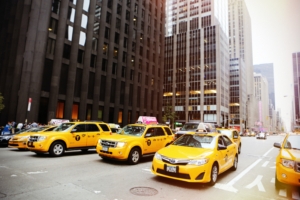The buzz on autonomous vehicles has died down a bit in the last five years. The Gartner Hype Curve for Connected Vehicles shows why. Many of these technologies are past the hype and are now coming to fruition. But the big question is: how will self-driving vehicles affect industries outside of carmakers and, most importantly, your business?
First, it will affect global commerce because of its size. It’s no wonder with the number of companies working on autonomous vehicles. Carmakers like Audi, BMW, Ford, GM, Mercedez-Benz, Tesla, Toyota, and Volkswagen are either working on or funding the technology. Software and technology companies like Amazon, Apple, Aptiv, Aurora, Baidu, Intel, Nvidia, and Waymo are building the backbone. Then cap that with hardware manufacturers like Bosch, Huawei, and Samsung. You can understand why experts say hundreds of thousands of driverless cars will be on the road in less than ten years.
But driverless cars are bigger than the automotive industry. Here are a few impacts of driverless cars that will change global industries and require new innovation.
Auto insurance: Where does liability fall?
 Auto insurance will change with driverless cars. We’ll no longer be insuring drivers as much as insuring cars. But insurance may be a moot point. Cars controlled by AI will speak with each other, almost guaranteeing the elimination of accidents on the roads. But the cars will still need to be insured against things outside of the car’s control (acts of God, wildlife, etc.). But who will need to insure the car? Is it the car owner who isn’t driving the car or the car manufacturer or software platform that will be responsible? The future will tell where the liability remains.
Auto insurance will change with driverless cars. We’ll no longer be insuring drivers as much as insuring cars. But insurance may be a moot point. Cars controlled by AI will speak with each other, almost guaranteeing the elimination of accidents on the roads. But the cars will still need to be insured against things outside of the car’s control (acts of God, wildlife, etc.). But who will need to insure the car? Is it the car owner who isn’t driving the car or the car manufacturer or software platform that will be responsible? The future will tell where the liability remains.
Autobody, parts, and accessories: Is this the death of an industry?
With fewer accidents on the roads comes less damage to vehicles. This means autobody shops will become almost obsolete. The only reason for their existence may for restoring or enhancing older vehicles, which may not be allowed on roads any longer. The other reason is for enhancing or modifying existing vehicles. But will people be as concerned about upgrading a vehicle that they don’t drive? The fate of auto parts stores and autobody shops hangs in the balance as we see whether people will still identify with their vehicles.
Businesses that deliver: Just along for the ride?
 2020 has shown the importance of delivery and its need in our economy. So what happens when you don’t need a driver in that delivery truck? As we transition from drivers to driverless, delivery will need to change. We may not have things brought to our door by a human any longer. This means less risk of infection from human contact, no human error, and no need to tip your driver. But while this is great for consumers, it eliminates a lot of jobs for people that need the income. Many families, college students, and teenagers will take a bit hit with their finances. And what about long haul truckers? As their jobs become obsolete, what can they do? Will they be needed or will they be doing other jobs as they sit in the truck? What other jobs will surface to help these individuals have the money they need?
2020 has shown the importance of delivery and its need in our economy. So what happens when you don’t need a driver in that delivery truck? As we transition from drivers to driverless, delivery will need to change. We may not have things brought to our door by a human any longer. This means less risk of infection from human contact, no human error, and no need to tip your driver. But while this is great for consumers, it eliminates a lot of jobs for people that need the income. Many families, college students, and teenagers will take a bit hit with their finances. And what about long haul truckers? As their jobs become obsolete, what can they do? Will they be needed or will they be doing other jobs as they sit in the truck? What other jobs will surface to help these individuals have the money they need?
Elimination of traffic: Ready for a blissful commute?
 Autonomous drivers are not only safer, but they are also better than human drivers. And because they will have the capacity to coordinate with other AI cars on the road, they can move together. This means the ability to have six lanes of traffic where only four existed before. Add all the other coordination they can do and traffic will be all but eliminated. This has many implications.
Autonomous drivers are not only safer, but they are also better than human drivers. And because they will have the capacity to coordinate with other AI cars on the road, they can move together. This means the ability to have six lanes of traffic where only four existed before. Add all the other coordination they can do and traffic will be all but eliminated. This has many implications.
Commutes will shorten. This will move people further away from big cities where the cost of living is lower. And if you’re not driving, you can get more done. This means more time for workers to be productive. They may take this time back for themselves with hobbies or entertainment. They could also get a head start on work before arriving or leave early to work on the way home.
Reduction of traffic, no collisions, no speeding, and no road rage means no tickets for law enforcement and highway patrols. This will remove a large source of revenue for cities and states. It could also reduce the number of law enforcement members needed.
Travel and hospitality: Is your driverless car now a mobile hotel?
The days of stopping on your road trip to rest and revive may be over. When you’re not driving, you don’t need to stop to recharge. Cars can drive all night and will let consumers drive further than they wanted to before. This could mean more road trips and make people more willing to travel further distances. It could also be bad for hotels and motels, reducing nights spent in places “on the road”.
Taxis and transportation: Will you need to own a car in 10 years?
 The prevalence of autonomous cars will make some consumers question the need to own a car. And for those that still want one, they won’t have to park it while they’re not using it. Their driverless car can now make them money too. Companies like Lyft and Uber can still use their current business model, but they won’t have the driver in the equation. This may make their business model even simpler. Cars can become tools for work, collecting fares and taking people to where they need to go. This will disrupt the taxi industry even further, and could almost end it. Look for cab companies to convert their fleets to autonomous vehicles or partner with rideshare programs to give them guaranteed access to vehicles.
The prevalence of autonomous cars will make some consumers question the need to own a car. And for those that still want one, they won’t have to park it while they’re not using it. Their driverless car can now make them money too. Companies like Lyft and Uber can still use their current business model, but they won’t have the driver in the equation. This may make their business model even simpler. Cars can become tools for work, collecting fares and taking people to where they need to go. This will disrupt the taxi industry even further, and could almost end it. Look for cab companies to convert their fleets to autonomous vehicles or partner with rideshare programs to give them guaranteed access to vehicles.
Parking: How will parking lots and garages be repurposed?
If your car isn’t waiting for you to finish at work and stays on the road, the need for parking becomes eliminated. In large cities, parking garages and lots fill the city. And parking tickets are a great source of revenue. These will become obsolete. This opens up opportunities to use parking lots for new things, like buildings or green spaces. And parking garages will need to have a new purpose. This presents new opportunities for destroying or repurposing parking structures. But cities won’t have a monopoly. Fewer people requiring cars will lead many people to remove garages from their homes, opting for more accessible storage. The home of the future may be very different without the garage we know today.
Sports and leisure: If driving is commoditized, will people care about it?
 What we know today about driving may be a thing of the past. When cars are autonomous, will people still want to experience driving for themselves? Will they want to watch other people do it? Car ownership for the thrill of driving may be difficult to find. It could open up raceways, towns, or private roads reserved for those that wish to drive. Much like people use horses today (the previous mode of transportation), this may be how we see cars in the future.
What we know today about driving may be a thing of the past. When cars are autonomous, will people still want to experience driving for themselves? Will they want to watch other people do it? Car ownership for the thrill of driving may be difficult to find. It could open up raceways, towns, or private roads reserved for those that wish to drive. Much like people use horses today (the previous mode of transportation), this may be how we see cars in the future.
And what of the racing industry today? Will we pay to watch people drive, as we watch jockeys on racehorses or cowboys ride at rodeos? Will it be interesting when driving becomes something we forgot humans did first?
Automakers: Selling metal or megabytes?
As driverless cars become more popular, people will be less likely to buy cars. They will keep cars for longer or retrofit current cars for autonomous driving. Will carmakers become less about bending metal and more about software? Will autonomous cars live in beta much like technology lives today? Are you buying an upgrade plan for your car rather than concerned about oil changes and scheduled maintenance? How will this technology affect the overall price of the vehicle? And where will the revenue come from – the vehicle itself or the technology embedded in it? Will Silicon Valley replace or own Detroit? Will they be selling to consumers anymore or to fleet companies that employ driverless cars and give access to the masses? With the number of global companies vying for dominance right now, the jury is still out on who will win.
Advertising: what happens when people don’t look outside of the vehicle?
 Driverless cars will allow people to focus on something besides driving. This will make the inside of the car look different than it does today, and it will allow different seat configurations inside of the car. This will have our views focused inside of the car and on the screens we own. With fewer people looking outside of the vehicle, it will affect billboards, signage, and other physical forms of advertising. This means digital will gain more importance to advertisers. But there are other opportunities inside the car as well. Car manufacturers can take advantage of the real estate in the car on windows and screens. They can gain additional revenue by using their vehicles as potential billboards.
Driverless cars will allow people to focus on something besides driving. This will make the inside of the car look different than it does today, and it will allow different seat configurations inside of the car. This will have our views focused inside of the car and on the screens we own. With fewer people looking outside of the vehicle, it will affect billboards, signage, and other physical forms of advertising. This means digital will gain more importance to advertisers. But there are other opportunities inside the car as well. Car manufacturers can take advantage of the real estate in the car on windows and screens. They can gain additional revenue by using their vehicles as potential billboards.
Make autonomous vehicles work for you
Disruption will occur in many industries as a result of autonomous driving. The next ten years will see a lot of shakeups. By planning for these changes now, you can stay relevant and profit from the disruption.


